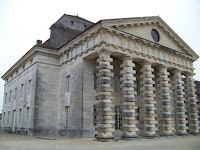
Imagine a political climate in which politicians urge citizens that murdering one another might actually be a moral option worth pursuing in the event of a disagreement. Perhaps they would suggest that in unusually difficult times and only in moments of exceptional rage, murder could be overlooked, or even encouraged. Or imagine a climate in which political leaders subtly defended our right as citizens to steal. After all, consider what has been stolen from you via interest from greedy banks or profits from big business. Theft is a way to get even, to level the playing field. Of course it isn't the ideal way to solve a problem, but it is justifiable when you're up against enemies that don't play by the rules.
It is hard to imagine such a political climate precisely because we know murder and theft to be wrong. Even if not for the fifth or seventh commandments, no human civilization lifts up murder or theft as virtuous. Sure, we explore times of moral confusion when we want to justify such sins, or when we are legitimately unsure when the difference between, for example, "murder" and "kill" emerges. What about soldiers on the battlefield or a battered spouse in self-defense? Is that murder? Or I think of The Bicycle Thief as an exploration of how desperate people behave in ways they otherwise would not. The point is, the commission of such acts, even in extreme cases, is almost always considered wrong. We know it to be wrong instinctively, and our Judeo-Christian culture certainly reinforces it.
Murder and theft, of course, are not the only commandments we are to live by, even in a secular world. They are, perhaps, the "hardest" of all the commandments. That is, society feels the effects of these broken commandments, although not honoring our parents, committing adultery, and lying rank pretty high as well. The first three commandments pertaining to our relationship to God (no other gods, do not take the Lord's name in vein, and honor the Sabbath) effect society if broken to be sure, but not as directly as murder or theft. The first three are what you might call "soft" commandments; following them is a relatively private affair.
That brings us to the ninth and tenth commandments: you shall not covet your neighbor's wife, and all his possessions. Some church traditions yoke these commandments together, making no distinction between your neighbor's wife and his stuff. Most Protestant (and I believe Roman Catholic) traditions separate these commandments, but that makes it easier to correlate them to the "harder" sins they lead to: adultery and theft.
These two commandments make up 20% of the great Ten Commandments, but get scarce attention, probably because they are "soft" commandments. Certainly society benefits when we are obedient to the commandments, but we often don't follow the ball long enough to see how they are a great detriment to societies when we are disobedient. We focus on the hard sins of murder and theft because we can legislate and prosecute them. But such hard sins always have their roots in the soft sin of coveting.
This commandment needs special attention in our day. It needs such attention precisely because we do live in a political climate where politicians encourage us to covet. For some reason, we will not tolerate politicians who subtly encourage us to murder, but we elect them to represent us when they invite us to covet.
Perhaps we overlook this because no politician will come out and tell us to covet. But they do encourage us to covet every time they engage in demagogic class warfare. Whenever a politician speaks about certain members of society paying their "fair share", coveting is being encouraged. Wherever the welfare state is lauded as salutary, we should expect that coveting will be the end result. The recent debt deal stalled precisely because one side wanted to use coveting to force tax increases on those who "could afford it," those who needed to put more "skin in the game."
More examples abound. The rioting in London, where entitled children of the welfare state justify their crimes because the business owners are rich, are prime coveters. Flash mobs here seem to operate on the same premise, that it is okay to rob a store because the corporation never did any good anyway. I would also go so far as to say that a spate of racial crimes of late, and indeed the entire racial victimization phenomenon is rooted in covetousness. White, in some circles, is synonymous with rich, privileged or entitled.
It is no better to encourage coveting any more than it is good to encourage one another to kill, steal, or lie. Politicians and the culture can feel free to ignore the first three commandments; they deal more with man's relationship to God. But the next seven speak to how we live together as a community, and even most secularists would endorse them as good. Just because the softer of these commandments, mainly those pertaining to what happens in the mind, exact a cheaper cost on society doesn't make it acceptable to encourage them. Because the soft sins lead to hard sins, politicians and cultural leaders should do everything in their power to speak about service to one another, showing honor to one another, and respecting one another. That is how the polis survives. Encouraging us to covet only destroys.
Why don't we hold politicians who encourage us to covet to account? I suppose because we like to covet. Politicians are surely complicit in our sin, but we're the ones who love to commit them. If we can't rely on our elected leaders, we will need to rely on ourselves to know what coveting is, when we commit it, and how to stop. Coveting can only lead to resentment at best and hard crimes at worst.






